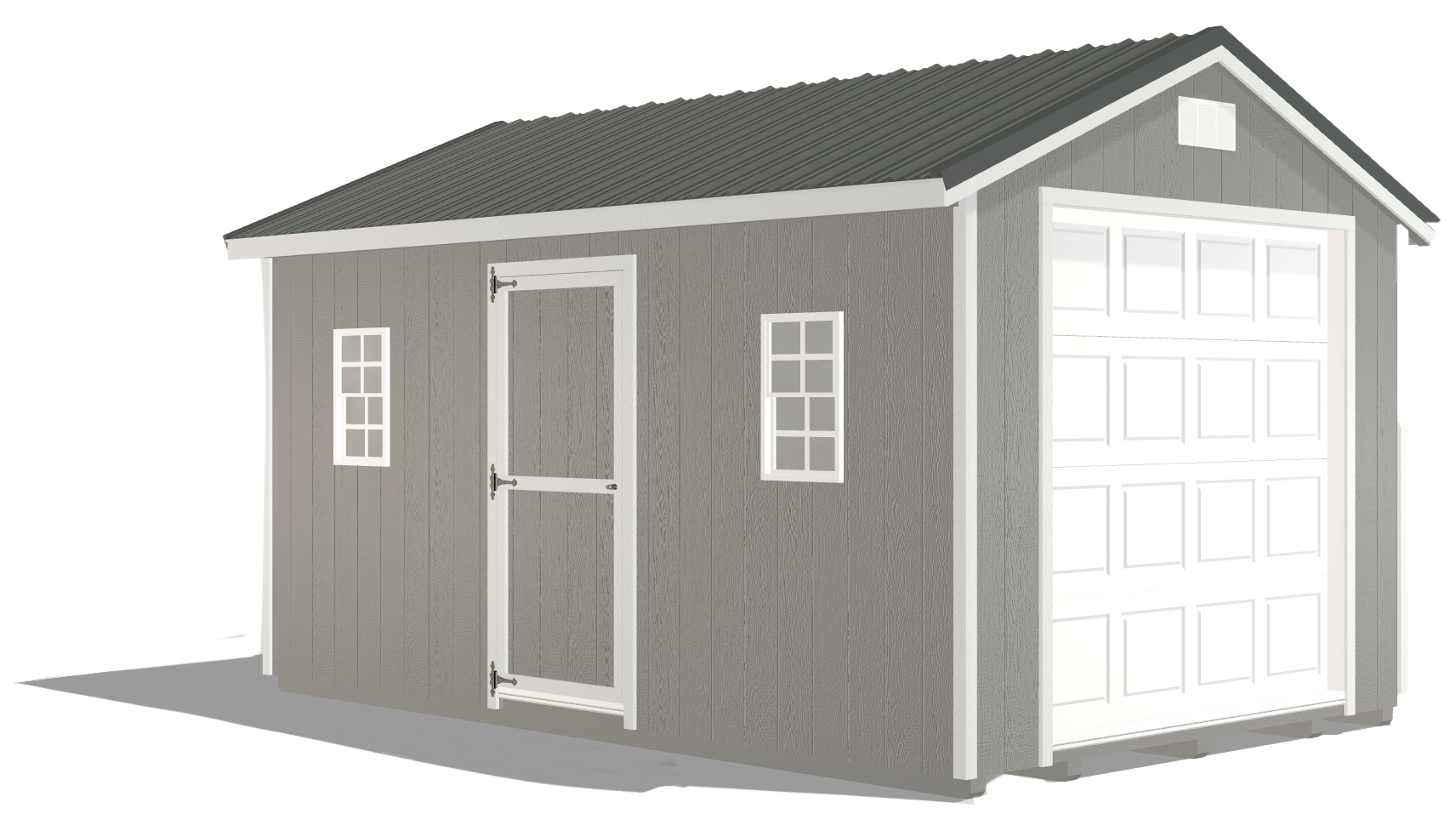Greenhouse Gardening: How to Grow Fresh Produce All Year Long
by Dakota Storage Buildings, on July 16, 2025

Greenhouse gardening is a year-round strategy for growing fresh, flavorful produce no matter the season. From juicy berries and crisp greens to heat-loving tomatoes and peppers, a greenhouse opens the door to more variety, longer harvest windows, and better control over growing conditions.
However, you need more than just a shelter. It’s about choosing the right crops, managing temperature and humidity, and using smart techniques like companion planting and vertical growing.
In this guide, we’ll walk you through everything you need to grow fruit, vegetables, and specialty crops with confidence.
How to Choose Vegetables That Thrive in a Greenhouse
The key to greenhouse success starts with choosing the right greenhouse vegetables. Selecting crops that thrive in controlled environments ensures healthy growth and maximizes your yields.
Look for vegetables that match the specific climate and conditions you can provide. By choosing compatible greenhouse plants, you will set the stage for a productive and rewarding greenhouse garden.

Crops like tomatoes, cucumbers, peppers, and lettuce thrive in greenhouse conditions, as they benefit from stable temperatures and consistent moisture. Herbs like basil, cilantro, and mint are also excellent choices for smaller spaces.
To maximize your vegetable yields:
- Maintain a steady temperature between 65°F and 75°F for warm-season crops.
- Provide ample light by placing your greenhouse in a sunny location or using grow lights in winter months.
- Rotate crops seasonally, growing cool-weather vegetables like spinach and kale during the colder months.
Discover the top vegetables to grow in your greenhouse for maximum yield and flavor.
Your Guide to Creating the Perfect Growing Environment
Creating the right environment is essential for healthy and productive plants. This means carefully managing key factors like temperature, humidity, light, and ventilation to mimic the ideal growing conditions for your crops.

A well-regulated environment boosts plant growth and helps prevent common issues like pest infestations and diseases. Whether you are growing warm-season greenhouse vegetables like tomatoes or cool-weather crops like spinach, maintaining the right balance ensures your greenhouse plants thrive year-round.
- Temperature: Maintain consistent temperatures by using heaters in the winter and ventilation systems or shade cloths in the summer.
- Humidity: Aim for moderate humidity levels (50%-80%) to prevent plant stress and reduce the risk of mold.
- Ventilation: Ensure proper airflow with adjustable vents and fans to keep air circulating and regulate temperature.
Providing plants with the correct soil or growing medium is equally important. Choose nutrient-rich, well-draining soil and supplement it with organic fertilizers to boost plant health.
For watering, use drip irrigation or hand watering to maintain consistent moisture levels without overwatering.
Learn how to create the perfect environment for your greenhouse plants to thrive.
Tips for Maintaining a Healthy and Productive Greenhouse
Creating a thriving greenhouse garden requires more than just planting the right crops—it is about maintaining a space that supports healthy growth and simplifies your daily tasks. From arranging plants strategically to ensuring a stable climate, a functional greenhouse layout is the foundation for success.
By focusing on pest control, consistent maintenance, and smart organization, you can turn your greenhouse into a productive and efficient space that keeps your plants flourishing year-round.

Here are a few things you should keep in mind:
- Functional Layout: Arrange plants based on their sunlight and temperature needs, placing taller plants near the back or sides to avoid shading shorter ones.
- Stable Climate: Invest in a thermometer and hygrometer to monitor temperature and humidity regularly.
- Pest Control: Use natural remedies like neem oil or beneficial insects to manage pests, and inspect plants regularly for signs of infestation.
- Consistent Maintenance: Establish a routine for watering, pruning, and cleaning your greenhouse to keep it running efficiently.
Explore essential tips to ensure your greenhouse garden thrives year-round.
Should You Choose Hydroponics or Soil?
Greenhouses allow you to experiment with different growing methods, including hydroponics and traditional soil-based systems.

Whether you opt for hydroponics or soil-based gardening, each approach offers unique benefits tailored to specific crops and gardening goals. Understanding the strengths of each method can help you create a greenhouse setup that maximizes growth and meets your greenhouse gardening needs.
- Hydroponics: This soilless method involves growing plants in nutrient-rich water, offering precise control over nutrients and water usage. It is ideal for crops like lettuce, spinach, and herbs.
- Soil-Based Growing: Traditional gardening with soil provides natural support and nutrient retention. It is best suited for plants with deep root systems like tomatoes and peppers.
Keep reading to decide whether hydroponics or soil is the best method for your greenhouse.
Transform Your Greenhouse With Exotic Plants and Fresh Fruits
Expand your greenhouse gardening by cultivating plants you typically may not be able to grow in your local climate. Orchids, citrus trees, and tropical flowers like hibiscus thrive in greenhouses when temperature and humidity are carefully managed.
By mimicking their native environments, you can enjoy vibrant blooms, fresh fruits, and unique foliage that transform your greenhouse into a lush paradise.
Here are a few best practices for growing exotic plants:
- Keep the temperature between 75°F and 85°F for tropical plants.
- Use misting systems to maintain higher humidity levels.
- Provide ample light through grow lights during shorter days.
Growing exotic plants can transform your greenhouse into a vibrant, tropical retreat while adding variety to your greenhouse gardening routine.
Learn how to grow exotic plants that transform your greenhouse into a tropical paradise.
Maximize Your Greenhouse Potential With Companion Planting
Companion planting is a proven method to boost greenhouse productivity and plant health. This method reduces reliance on chemical pesticides and promotes healthy pollination.

By pairing compatible plants together, you can create a more efficient and balanced greenhouse ecosystem. Let’s explore how the right pairings can transform your garden into a thriving and harmonious environment.
- Effective Pairings: Pair tomatoes with basil to deter pests and improve flavor. Marigolds planted near vegetables help repel nematodes and aphids, while beans planted near corn can provide mutual support and nitrogen enrichment.
- What to Avoid: Avoid planting tomatoes and cucumbers too closely because both are heavy feeders and can compete for nutrients. Onions can stunt bean growth due to incompatible root interactions.
- Benefits: Companion planting optimizes space, reduces the need for chemical pesticides, and promotes healthy pollination by attracting beneficial insects.
By strategically pairing plants, you can create a balanced ecosystem in your greenhouse, leading to higher yields and healthier crops.
See how you can boost your greenhouse garden with companion planting techniques.
Maximize Your Greenhouse by Adding Fruit to the Mix
Most people associate greenhouses with vegetables, but they’re also a great place to grow sweet, juicy fruit. With a little planning, you can enjoy fresh strawberries, citrus, figs, and even small melons earlier and longer than you could outdoors.

- Strawberries are a great place to start. They thrive in containers and hanging baskets, making them ideal for greenhouse setups of any size.
- Dwarf citrus trees like lemons and mandarins love the warm, humid greenhouse environment and can produce fruit year-round in the right conditions.
- Figs also do well with consistent warmth.
- Small melon varieties like cantaloupe can be trained vertically to save space.
Of course, greenhouse fruit does come with its own set of needs. You’ll want to maintain consistent temperatures and humidity levels to support flowering and fruiting. Well-draining, compost-rich soil helps establish strong roots, and added nutrients like worm castings or organic fertilizer support healthy growth.
One thing many growers overlook is pollination. Because most greenhouses are enclosed, bees and other pollinators may not be able to access the plants. Hand-pollinating with a soft brush or encouraging airflow with fans can help move pollen around. Some gardeners even open the greenhouse during the day to let natural pollinators in.
Discover more tips for growing fresh berries and fruit in a greenhouse.
Get the Most From Your Greenhouse Tomatoes and Peppers
Tomatoes and peppers are greenhouse favorites. They’re heat-loving, productive, and great for everything from salads to sauces. But to really thrive, they need the right conditions from the start.
Temperature matters. These plants prefer daytime temps around 75–85°F, with temperatures a little cooler at night. High humidity can be a problem, especially when paired with poor airflow, so good ventilation is a must. Use roof vents, side vents, or oscillating fans to keep fresh air moving and reduce disease risk.

Tomatoes and peppers are also heavy feeders and need rich, well-draining soil. Raised beds or 5-gallon containers filled with compost and a slow-release organic fertilizer can set your plants up for success. Keep the soil evenly moist and avoid overhead watering to limit fungal issues.
Don’t forget support. Even though they aren’t vines, tomatoes and peppers can grow tall and produce heavy fruit. Trellises, cages, or hanging string systems keep plants upright and healthy while maximizing airflow and space. Greenhouses are perfect for vertical growing, so take advantage of the height.
Prevent pest problems by inspecting plants regularly, using sticky traps, and introducing beneficial insects like ladybugs. If pests do show up, organic treatments like neem oil or insecticidal soap can help keep populations under control.
A few simple setup tweaks can go a long way toward higher yields and healthier plants.
Explore more best practices for growing greenhouse tomatoes and peppers.
Greenhouse Gardening That Works in Every Season
Greenhouse gardening gives you the opportunity to grow much more than vegetables. With the right setup, you can enjoy everything from strawberries and citrus to hearty greens and flavorful herbs all year long.
The secret? Matching each plant’s needs with the right environment, layout, and care routine. When done well, a greenhouse becomes a self-sustaining space that supports high yields.
Ready to create your own year-round garden? Explore our durable, versatile greenhouses and start planning your backyard growing space today.

























